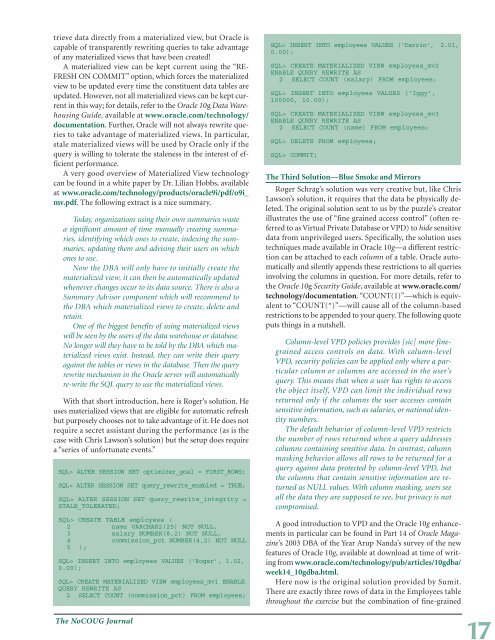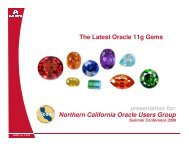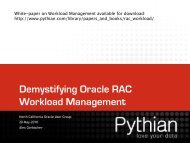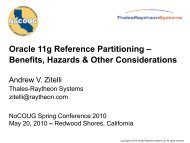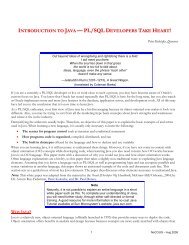Q&A with Juan Loaiza Stay Focused on the Five Steps ... - NoCOUG
Q&A with Juan Loaiza Stay Focused on the Five Steps ... - NoCOUG
Q&A with Juan Loaiza Stay Focused on the Five Steps ... - NoCOUG
Create successful ePaper yourself
Turn your PDF publications into a flip-book with our unique Google optimized e-Paper software.
trieve data directly from a materialized view, but Oracle is<br />
capable of transparently rewriting queries to take advantage<br />
of any materialized views that have been created!<br />
A materialized view can be kept current using <strong>the</strong> “RE<br />
FRESH ON COMMIT” opti<strong>on</strong>, which forces <strong>the</strong> materialized<br />
view to be updated every time <strong>the</strong> c<strong>on</strong>stituent data tables are<br />
updated. However, not all materialized views can be kept current<br />
in this way; for details, refer to <strong>the</strong> Oracle 10g Data Warehousing<br />
Guide, available at www.oracle.com/technology/<br />
documentati<strong>on</strong>. Fur<strong>the</strong>r, Oracle will not always rewrite queries<br />
to take advantage of materialized views. In particular,<br />
stale materialized views will be used by Oracle <strong>on</strong>ly if <strong>the</strong><br />
query is willing to tolerate <strong>the</strong> staleness in <strong>the</strong> interest of efficient<br />
performance.<br />
A very good overview of Materialized View technology<br />
can be found in a white paper by Dr. Lilian Hobbs, available<br />
at www.oracle.com/technology/products/oracle9i/pdf/o9i_<br />
mv.pdf. The following extract is a nice summary.<br />
Today, organizati<strong>on</strong>s using <strong>the</strong>ir own summaries waste<br />
a significant amount of time manually creating summaries,<br />
identifying which <strong>on</strong>es to create, indexing <strong>the</strong> summaries,<br />
updating <strong>the</strong>m and advising <strong>the</strong>ir users <strong>on</strong> which<br />
<strong>on</strong>es to use.<br />
Now <strong>the</strong> DBA will <strong>on</strong>ly have to initially create <strong>the</strong><br />
materialized view, it can <strong>the</strong>n be automatically updated<br />
whenever changes occur to its data source. There is also a<br />
Summary Advisor comp<strong>on</strong>ent which will recommend to<br />
<strong>the</strong> DBA which materialized views to create, delete and<br />
retain.<br />
One of <strong>the</strong> biggest benefits of using materialized views<br />
will be seen by <strong>the</strong> users of <strong>the</strong> data warehouse or database.<br />
No l<strong>on</strong>ger will <strong>the</strong>y have to be told by <strong>the</strong> DBA which materialized<br />
views exist. Instead, <strong>the</strong>y can write <strong>the</strong>ir query<br />
against <strong>the</strong> tables or views in <strong>the</strong> database. Then <strong>the</strong> query<br />
rewrite mechanism in <strong>the</strong> Oracle server will automatically<br />
re-write <strong>the</strong> SQL query to use <strong>the</strong> materialized views.<br />
With that short introducti<strong>on</strong>, here is Roger’s soluti<strong>on</strong>. He<br />
uses materialized views that are eligible for automatic refresh<br />
but purposely chooses not to take advantage of it. He does not<br />
require a secret assistant during <strong>the</strong> performance (as is <strong>the</strong><br />
case <str<strong>on</strong>g>with</str<strong>on</strong>g> Chris Laws<strong>on</strong>’s soluti<strong>on</strong>) but <strong>the</strong> setup does require<br />
a “series of unfortunate events.”<br />
SQL> ALTER SESSION SET optimizer_goal = FIRST_ROWS;<br />
SQL> ALTER SESSION SET query_rewrite_enabled = TRUE;<br />
SQL> ALTER SESSION SET query_rewrite_integrity =<br />
STALE_TOLERATED;<br />
SQL> CREATE TABLE employees (<br />
2 name VARCHAR2(25) NOT NULL,<br />
3 salary NUMBER(8,2) NOT NULL,<br />
4 commissi<strong>on</strong>_pct NUMBER(4,2) NOT NULL<br />
5 );<br />
SQL> INSERT INTO employees VALUES (‘Roger’, 1.02,<br />
0.00);<br />
SQL> CREATE MATERIALIZED VIEW employees_mv1 ENABLE<br />
QUERY REWRITE AS<br />
2 SELECT COUNT (commissi<strong>on</strong>_pct) FROM employees;<br />
The <strong>NoCOUG</strong> Journal<br />
SQL> INSERT INTO employees VALUES (‘Darrin’, 2.01,<br />
0.00);<br />
SQL> CREATE MATERIALIZED VIEW employees_mv2<br />
ENABLE QUERY REWRITE AS<br />
2 SELECT COUNT (salary) FROM employees;<br />
SQL> INSERT INTO employees VALUES (‘Iggy’,<br />
100000, 10.00);<br />
SQL> CREATE MATERIALIZED VIEW employees_mv3<br />
ENABLE QUERY REWRITE AS<br />
2 SELECT COUNT (name) FROM employees;<br />
SQL> DELETE FROM employees;<br />
SQL> COMMIT;<br />
The Third Soluti<strong>on</strong>—Blue Smoke and Mirrors<br />
Roger Schrag’s soluti<strong>on</strong> was very creative but, like Chris<br />
Laws<strong>on</strong>’s soluti<strong>on</strong>, it requires that <strong>the</strong> data be physically deleted.<br />
The original soluti<strong>on</strong> sent to us by <strong>the</strong> puzzle’s creator<br />
illustrates <strong>the</strong> use of “fine grained access c<strong>on</strong>trol” (often referred<br />
to as Virtual Private Database or VPD) to hide sensitive<br />
data from unprivileged users. Specifically, <strong>the</strong> soluti<strong>on</strong> uses<br />
techniques made available in Oracle 10g—a different restricti<strong>on</strong><br />
can be attached to each column of a table. Oracle automatically<br />
and silently appends <strong>the</strong>se restricti<strong>on</strong>s to all queries<br />
involving <strong>the</strong> columns in questi<strong>on</strong>. For more details, refer to<br />
<strong>the</strong> Oracle 10g Security Guide, available at www.oracle.com/<br />
technology/documentati<strong>on</strong>. “COUNT(1)”—which is equivalent<br />
to “COUNT(*)”—will cause all of <strong>the</strong> columnbased<br />
restricti<strong>on</strong>s to be appended to your query. The following quote<br />
puts things in a nutshell.<br />
Column-level VPD policies provides [sic] more finegrained<br />
access c<strong>on</strong>trols <strong>on</strong> data. With column-level<br />
VPD, security policies can be applied <strong>on</strong>ly where a particular<br />
column or columns are accessed in <strong>the</strong> user’s<br />
query. This means that when a user has rights to access<br />
<strong>the</strong> object itself, VPD can limit <strong>the</strong> individual rows<br />
returned <strong>on</strong>ly if <strong>the</strong> columns <strong>the</strong> user accesses c<strong>on</strong>tain<br />
sensitive informati<strong>on</strong>, such as salaries, or nati<strong>on</strong>al identity<br />
numbers.<br />
The default behavior of column-level VPD restricts<br />
<strong>the</strong> number of rows returned when a query addresses<br />
columns c<strong>on</strong>taining sensitive data. In c<strong>on</strong>trast, column<br />
masking behavior allows all rows to be returned for a<br />
query against data protected by column-level VPD, but<br />
<strong>the</strong> columns that c<strong>on</strong>tain sensitive informati<strong>on</strong> are returned<br />
as NULL values. With column masking, users see<br />
all <strong>the</strong> data <strong>the</strong>y are supposed to see, but privacy is not<br />
compromised.<br />
A good introducti<strong>on</strong> to VPD and <strong>the</strong> Oracle 10g enhancements<br />
in particular can be found in Part 14 of Oracle Magazine’s<br />
2003 DBA of <strong>the</strong> Year Arup Nanda’s survey of <strong>the</strong> new<br />
features of Oracle 10g, available at download at time of writing<br />
from www.oracle.com/technology/pub/articles/10gdba/<br />
week14_10gdba.html.<br />
Here now is <strong>the</strong> original soluti<strong>on</strong> provided by Sumit.<br />
There are exactly three rows of data in <strong>the</strong> Employees table<br />
throughout <strong>the</strong> exercise but <strong>the</strong> combinati<strong>on</strong> of finegrained<br />
1


